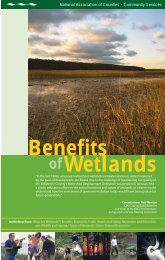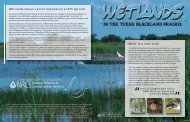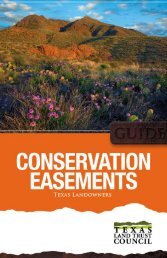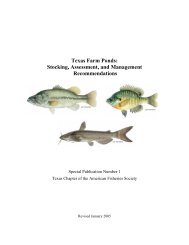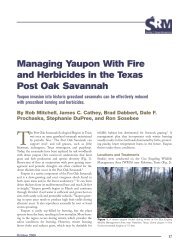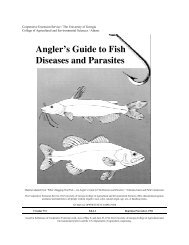Managing for Wood Ducks in East Texas - Trinity Waters
Managing for Wood Ducks in East Texas - Trinity Waters
Managing for Wood Ducks in East Texas - Trinity Waters
Create successful ePaper yourself
Turn your PDF publications into a flip-book with our unique Google optimized e-Paper software.
NEST BOX Construction<br />
Nest boxes may be made from a variety of materials. However, untreated<br />
lumber should be used. The chemicals used <strong>in</strong> lumber pressure-treated with<br />
wood preservatives may be toxic to wood duck eggs or duckl<strong>in</strong>gs. Soft woods<br />
such as p<strong>in</strong>e, cypress, cedar, or redwood are recommended because : 1) they can<br />
be worked easily, and, 2) they don't warp or crack as readily as hardwoods.<br />
Special nails or screws may be required <strong>for</strong> redwood and some types of cedar<br />
because these woods do not hold standard nails well. Plywood, even exterior<br />
grade, does not prove as durable as board lumber. Two coats of exterior pa<strong>in</strong>t<br />
should be applied if plywood is used <strong>for</strong> box material. Southern yellow p<strong>in</strong>e is<br />
a good choice <strong>for</strong> nest boxes because it is <strong>in</strong>expensive, available, and durable.<br />
Lumber dimensions of 1" x 10" or 1" x 12" are best.<br />
An alternative method <strong>for</strong> extend<strong>in</strong>g wood durability is to construct nest boxes<br />
from untreated lumber, then apply a coat<strong>in</strong>g of exterior pa<strong>in</strong>t or wood<br />
preservative to the outside of the box.<br />
Nest boxes can be built with m<strong>in</strong>imum tools. A hand saw, hammer, tape measure<br />
and carpenter’s square are adequate. Naturally, power hand tools or shop tools<br />
would facilitate ease and speed of box construction. Box nails of 6-penny or 8-<br />
penny size are best. Drywall screws may be substituted <strong>for</strong> nails <strong>in</strong> softer<br />
lumber. Seams may be glued if this added quality is desired.<br />
A construction plan <strong>for</strong> a nest box version recommended by the TPWD<br />
waterfowl program is shown <strong>in</strong> Figure 8. Study this plan carefully be<strong>for</strong>e<br />
beg<strong>in</strong>n<strong>in</strong>g box construction. Be sure the hardware cloth "ladder" is attached<br />
securely <strong>in</strong>side the front of the box. This should be done be<strong>for</strong>e the front panel<br />
is nailed together with the sides, or, be<strong>for</strong>e the top is nailed on. A useful trick<br />
<strong>for</strong> the side door is to mark the door location, then nail the side <strong>in</strong>to the place<br />
without cutt<strong>in</strong>g the door (be sure not to place nails through the door portion).<br />
Next apply the door h<strong>in</strong>ge and the nails <strong>for</strong> wire fasten<strong>in</strong>g. You will f<strong>in</strong>d these<br />
steps provide a firm base <strong>for</strong> driv<strong>in</strong>g the h<strong>in</strong>ge screw and the fasten<strong>in</strong>g nails.<br />
After this has been done, a keyhole saw or power saw may be used to cut the<br />
door portion <strong>in</strong> the side. Some bevel<strong>in</strong>g at the side may be necessary if the<br />
door fits too snugly. A 4-<strong>in</strong>ch diameter entrance hole should be cut if use by<br />
black-bellied whistl<strong>in</strong>g ducks is expected.<br />
FIGURE 8<br />
Construction Plan <strong>for</strong> a<br />
<strong>Wood</strong> Duck Nest Box<br />
10˝<br />
FRONT VIEW<br />
PILOT HOLES FOR<br />
NAILS TO ATTACH<br />
TO POST<br />
3˝<br />
3-1/4˝ x 4˝ OPENING<br />
4˝ x 16˝<br />
1/4˝ HARDWARE CLOTH<br />
(ATTACHED INSIDE)<br />
5 - 10 DRAIN HOLES<br />
DRILLED IN BOTTON<br />
Soft woods such as<br />
p<strong>in</strong>e, cypress, cedar<br />
or redwood are<br />
recommended because:<br />
1) they can be worked<br />
easily, and;<br />
2) they don't warp or<br />
crack as readily as<br />
hardwoods.<br />
18<br />
MANAGING FOR WOOD DUCKS IN EAST TEXAS




